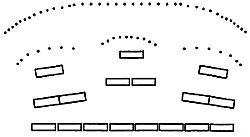Note from Editor: Part I covering the skirmisher tactics of France and England was published in EE&L 14. Part III on Russia and the United States will be published in EE&L 16.
Austrian Skirmishers
In a post Napoleonic work by Valentini, an Austrian officer, many of the skirmisher techniques used during the Napoleonic period are repeated and a few more points made which were no doubt valid for the manner in which skirmish warfare was conducted during the Napoleonic wars.
Valentini states that the officers charged with coordinating a skirmish line should establish a rally point at which their men can pull together and reorganize if they are pushed back. The skirmish line was always to be supported by a formed reserve.
Skirmishers were always to be 100 paces in front of the infantry they were covering. They could begin their fire on an enemy at ranges up to 300 paces.
When attacked by formed infantry they were to maneuver so as to attack uncovered flanks. If unable to do this they were to withdraw slowly and hinder the attack of the enemy by their fire.
When covering the charge of their own infantry the skirmishers were to advance and attempt to keep the front of the charging infantry clear of enemy skirmishers. They could keep up with the advance because they were not formed and the terrain problems would not affect them.
The Austrian 1807 Infantry Regulation is one of the few official regulations that goes into any depth on skirmishing. This regulation calls out for situations where skirmishers are to be used:
- when in a defensive position to keep the enemy skirmishers away from your line,
- to mask or screen the fronts and flanks of advancing formed infantry,
- to cover the withdrawal of formed troops from enemy skirmishers, and
- to mask the flank march of a column of formed infantry from enemy skirmishers.
These conditions were principally used in open terrain where formed troops were exposed to observation by enemy skirmishers.
The Austrian 1807 regulation clearly states that it was the third rank of the infantry company that was detached for this duty. If the entire third rank was deployed depended on how broken the terrain was, the level of fatigue of the skirmishers, or if the skirmish line has taken heavy casualties. It was estimated that 60-80 skirmishers were sufficient to support a battalion.
When the third rank was deployed as skirmishers these skirmishers were drawn from the first and, if necessary, second Zügen of the right and left flank companies. The Zügen doubled up so that there were two ranks and pairs of skirmishers were formed. The line arranged itself so that there was a non-commissioned officer on each flank of a given Zug of skirmishers and a third non-commissioned officer was in the middle of the Zug skirmish line. The skirmishers moved at the doublirschritt and opened up until they were at six pace intervals. The skirmish screen established itself 300 paces in front of the battalion.
About 80-100 paces behind the screen a Zug stood in closed order to act as a reserve and quick support for the skirmish screen. At 100 paces further back the captain stood with the two remaining Zügen of the company as yet a further reserve.
When operating in skirmish screen the skirmishers alternated firing and loading so that one skirmisher in every pair was always loaded. This is quite typical of the period, however, one variation is that every maneuver was controlled by drum signals, in contrast to the French who used bugles and voice commands.
If able to react in time, the pairs of skirmishers were taught to form "hasty squares" known as klumpen. When forming a klumpen two to four pairs of skirmishers would rush together, form a knot and face outwards with bayonets lowered. They were also taught how to deal with a cavalry threat while in extended order. They were taught to get to the left side of the cavalry so that the cavalier was less able to strike with his saber or pistol against the skirmisher. They were also taught to use their bayonet against the breast of the cavalier's horse.
When in klumpen and under cavalry attack, the klumpen were to, when the attack subsided sufficiently, to move towards the reserves and, eventually back to the main battalion.
More Skirmisher Tactics
This article appears in MagWeb (Magazine Web) on the Internet World Wide Web. At right, Austrian Skirmish Formation, Dienst Reglement für die Kaiserlich-Königliche Infanterie, Plate 46, Austrian 1807 Regulation.
At right, Austrian Skirmish Formation, Dienst Reglement für die Kaiserlich-Königliche Infanterie, Plate 46, Austrian 1807 Regulation.
Part I: Intro and French Skirmishers
Part I: British Skirmishers
Part II: Austrian Skirmishers
Part III: Russian Skirmishers
Back to Empire, Eagles, & Lions Table of Contents Vol. 3 No. 1
Back to EEL List of Issues
Back to MagWeb Master Magazine List
© Copyright 1997 by Jean Lochet
Other military history articles and gaming articles are available at http://www.magweb.com
